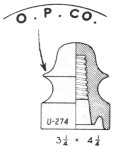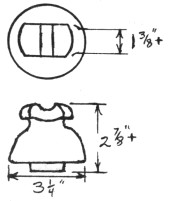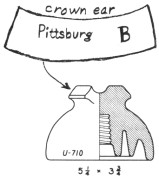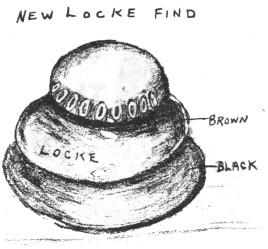Porcelain Insulator News
by Jack H. Tod
Reprinted from "INSULATORS - Crown Jewels of the Wire", December 1977, page 24
NEW PORCELAIN BOOK
By the tine you read this in early December, the following book should be
available:
ELECTRICAL PORCELAIN (A History of the Industry in the United States) by Jack
H. Tod, 1977, softbound, 8-1/2" X 11", 180 pages, $13.50. See ad in this issue.
This will be a real 'event" -- maybe not for you, but it certainly will
be for me. Originally planned in 1970, the research carried on intensively over
a 5-year span, and then the actual compilation was delayed at least a year by
sheer lack of energy to carry out this ambitious project to its ultimate end --
the publication of all my file data.
For several years I have been very
concerned that my file data on insulators might somehow get lost to collectors
and future historians; the house could burn down or I might pass on to higher
rewards Even discounting the thousands of hours of research tine involved, it
would be impossible for future researchers to duplicate my files -- people I
interviewed having passed away, porcelain companies having thrown out certain
old files, defunct plant sites being bulldozed away for new freeways, etc.
And
so, starting early last spring, I have devoted every spare moment to compiling
the book and getting it printed. Copies will be given to key agencies and
libraries where researchers can locate the material, and that will certainly
be a big relief to me.
Needless to say, CJ readers and other collectors may
purchase the book, but I won't twist your arm to do so. Any copies you purchase
will help pay the printing bill though.
This book contains virtually every fact I have ever been able to dig up on
electrical porcelain aside from that already published in my other book on pin
type insulators. It would have answered 90% of all the questions I have ever
received from CJ readers, and hopefully it will serve to answer many future
questions -- for those who have the book anyway. It would be impractical to
describe here the contents of the book in detail, but I can at least give you
some idea of it.
The book has chapters on the growth of the electrical industry from its
outset, the evolution of electrical porcelain insulators, the manufacturing
methods, etc. That's the first 66 pages.
It has detailed histories of all the porcelain companies (nearly 100
companies) that ever made dry press porcelain insulators, and that's the next 36
pages.
It shows every marking known on dry press porcelain and the company
attributions, That's another 16 pages.
It has a chapter on patents you won't believe until you see it -- the product
of thousands of hours doing patent searches three days per week over a period of
several years! Yes, 55 pages of tabulated and illustrated insulator patents from
1880 to date, nearly 700 patents in all. There never has been, or ever will be
again, such a gigantic list of insulator patents published for collectors, These
are only the patents of interest to collectors, picked out of the 4,000+
insulator patents I searched and have data on.
Even the glass insulator collector will have a ball with these data, or at
least some collectors will. The tabulated patents include many on glass
insulators which have never been published before. I won't elaborate here but
will leave the surprises for you. There are some not listed in Milholland or
elsewhere. Do you know the background on the CD203.2 by Armstrong?? The 1956
patent by A. T. & T. Co. on this item will enlighten you. It's listed, and
you can look it up too.
I have continually seen queries in CJ on glass whatisit insulators,
nest of which could have been answered by the patent listings in this new book,
but I have enough problems trying to answer porcelain questions without stepping
over into the realm of glass insulators too. Hopefully, glass insulator
researchers will carry on from the complete list of insulator patents I have
included in the book.
Jack

This anchor marking is known on very early over-surface wiring cleats, and we
have shown it as unattributed in past lists of markings in CJ. Not so now
though.
Recently while looking through the files for some other information, I noted
in the March 6, 1895 issue of "The Electrical Engineer" an artist's
cut of these cleats with this anchor marking under an announcement on Anchor
Electric Company, Boston. Another "unattributed" shot down.

Dear Jack:
I have an insulator that is closely matched to U-274. The shape is the same,
but the diameter is 1/16" smaller.
In your Porcelain Insulators book you have an insulator that is made by O. P.
Co. and it is worth $150.00. Mine has no name on it. Can you tell me whether
this piece is common or not, and what is the trade value? (Beautiful color photo
was enclosed, but color photos usually don't print well.)

Also I have another insulator. It has no name and fits closely the U-606A in
shape.

The size and shape of crown are a little different from the Universal Style
Chart. See sketch (at the left).
Again, is this common or not? I'll appreciate any information on these two
insulators. Thank you.
Richard A. Peterson
Oakland, Calif.
- - - - - - - - -
Dear Richard:
Your first item is the U-274. Porcelains vary so much in size that
most of the dimensions in the U- Chart are rounded off to meaningful values --
usually to the nearest 1/4", but sometimes to 1/8" on small sizes
(& 1/16" on real midgets).
I've never heard of U-274 except for the several known O. P. Co. specimens.
The marking is small and is embossed (raised letters) on the top edge of the
wire groove brow. I suggest that if yours is marked, the marking is obscured by
the heavy brown glaze. Look again in strong sunlight. I've looked at a photo
Jerry Turner once sent of his brown U-274 O. P. Co., and the item looks
identical with yours as nearly as I can tell -- photos taken at different
angles.
It isn't "me" that has this insulator, and it isn't "me"
that has it at $150. It is "us". Four of us played the game of
wild-guessing on insulator values for the price table, and the figures for this
one came out $150, 25, 175 and 125 -- so I used $150 as the consensus. (My
figure was the 150, and oddly it was Jerry Turner, who has the only pair of
these in white and brown I know of, who wrote down $25 on his sheet. Jerry
always was conservative in insulator pricing.)
In general, the prices in the book reflect what knowledgeable collectors
might pay to get an item. If you put one of these on the table at $100+, I'm
sure someone would want it at that; if you put even a crate of them on the table
at $25 each, they would all sell like hotcakes.
If the item is indeed unmarked, that's TUF. No company name, no ears -- ergo,
$1 to $3 or so, or maybe more to someone who just has to have a U-274 shape,
even unmarked.
Your item Sim U-606A is different -- crown more like the oldies, and
see the U-638A and 638B. I'd say these were of 1900-1910 vintage. Your item
probably is "rare ", since anything like that always got discarded as
lines were reworked. Value is something else. Even nice oldies like this don't
excite people's pocketbooks too much if they are brown and don't have ears or
company markings. I personally like these old styles, but what I buy for my own
insulator shelves as one individual doesn't affect the supply-demand equation.
Jack

Dear Jack:
While hunting insulators this summer in my home town in Canada, I came across
3 interesting little porcelain pieces. All three are white and have the same
dimensions.
The first one has STROMBERG CARLSON / HP in raised letters around the base.
Stromberg Carlson made radios in the 1930's.
The second one has MADE IN CANADA around the base and HP on the dome
top.
The third one has markings shown here (above) in raised letters on the front
and back of the bottom skirt.
Could you please give me some background information on these insulators: Are
they old? Are they rare? Are they valuable?
Robert Lloyd
4740 Brawley Ct.
St Louis, MO 63128
- - - - - - - - -

Dear Robert:
Many thanks for your report of these insulators.
The insulator itself is U-47, and all we have ever seen appear as if made
from dies formerly used by Porcelain Products, Inc. (Ohio). All are white glaze
and are identical except for the markings.
We have known of these U-47's coming out of Canada for some time, and I've
written them up in CJ three tines, the last time being April 1975, page
26. A number of collectors, including myself, have the following marking
varieties:
- HP / STROMBERG CARLSON (all on rim)
- HP / MADE IN CANADA (on rim) , plus CTS (on crown)
- MADE IN CANADA / STROMBERG CARLSON (all on rim)
- P. P. INC. (on crown, nothing on rim)
Your first one is like the first one in the above list, but your other two
are both new marking varieties.
The Monogram-HP marking is for Hamilton Porcelains, Ltd., Brantford, Ontario,
Canada. They formerly advised they made these insulators in the 1930-1945
period. With your specimens, it's now even more of a mystery why all these
marking varieties.
I have no way of knowing if your varieties are rare, but at least this is the
first I've heard of the two new ones. I'd think insulator collectors would want
to obtain all the varieties, so they're probably good tradeable items.
Jack

Dear Jack:
I just acquired a Sim. U-710 porcelain with a "Pittsburg" marking!
I have read your book & column many times and have read where one was
reported with the "Pittsburg" marking. Mine also has a large B
alongside the Pittsburg marking.
This insulator has all the characteristics of Pittsburg items, including the
concentric circles in top of the pin hole. It's a rich mahogany glaze and has a
Top Rest firing surface.
Could you please tell me about this insulator as regards value, rarity, and
any history? Also, could the "B" marking be related to the
"B" used by Brookfield Glass Co., since they used the B marking
1905-1920, and that's also when Pittsburg was in business?
David Bethman
Bellingham, Wash.
- - - - - - - - -
Dear David:
I can't tell you any more history about this insulator that that which you've
already read. Pittsburg pin types with this marking are obviously rare (thus
far), since this is only the second one I've ever heard of. I can't hazard a
guess as to its trade value, but it is safe to say that many collectors have
dreamed about someday getting a pin type with a "Pittsburg" marking on
it.
I have no way of knowing what the "B" marking would be for, but it
is pretty far out to suggest a connection with Brookfield just because the
initial fits and the companies were in operation at the same time. As far as I
know, there never was any inter-cataloging of items between companies that made
porcelain and glass insulators. Similarly, our dairy doesn't sell bread, and the
local bakery reciprocates by not selling milk!
Jack
 |
A LOCKE insulator that did not get into the
"LOCKE" book. I say this specimen at the Lakeland show. I did
not have the opportunity to sketch it there and I was sent a picture
from which this draying was made. It had an iron fitting and I judge
that it was used for street car electric lines.
Gerald Brown |
Gerald Brown (Two Buttes, Colo.) sent in this item, and as always for
Gerald, the sketch is a dandy. He wanted to know if maybe I could dig up some
info on this from my old catalogs.
Well, not much. We ran this item in the April 1974 CJ issue, page 14,
together with a photo cut from the 1934 Ohio Brass Co. catalog, and I have no
other info aside from that given then.
This was a hanger insulator for trolley span wires and was used as shown in
the 1974 CJ photo The extra skirt on Gerald's item looks like just more
icing on the cake.
The appearance of this specimen shows this may have been manufactured by
several companies as a standard trolley line insulator.

Dear Jack:
I picked up a mine insulator with an odd marking at the Levittown show. It's
embossed "SAFETY" on each side of the keyed pin hole as shown in my
sketch (here). It's dark brown in color. Any idea of whose marking this was?
Lew Hohn
Rochester, N.Y.
- - - - - - - - - -
Dear Lew:
I do seem to recall some paperwork in my files (or old catalogs and
directories) showing SAFETY as a trademark for mine insulators, but I spent a
couple of hours yesterday trying to locate it, all without success. As you
probably know, SECURITY was an Ohio Brass Co. trademark on similar nine
insulators, and you do see that once in awhile on mine insulator specimens.
Anyone else out there know who used this trademark on mine insulators??
Jack
| 